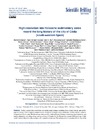Identificador persistente para citar o vincular este elemento:
https://accedacris.ulpgc.es/jspui/handle/10553/72995
| Campo DC | Valor | idioma |
|---|---|---|
| dc.contributor.author | Salomon, Ferréol | en_US |
| dc.contributor.author | Bernal-Casasola, Darío | en_US |
| dc.contributor.author | Díaz, José J. | en_US |
| dc.contributor.author | Lara, Macarena | en_US |
| dc.contributor.author | Domínguez-Bella, Salvador | en_US |
| dc.contributor.author | Ertlen, Damien | en_US |
| dc.contributor.author | Wassmer, Patrick | en_US |
| dc.contributor.author | Adam, Pierre | en_US |
| dc.contributor.author | Schaeffer, Philippe | en_US |
| dc.contributor.author | Hardion, Laurent | en_US |
| dc.contributor.author | Vittori, Cécile | en_US |
| dc.contributor.author | Chapkanski, Stoil | en_US |
| dc.contributor.author | Delile, Hugo | en_US |
| dc.contributor.author | Schmitt, Laurent | en_US |
| dc.contributor.author | Preusser, Frank | en_US |
| dc.contributor.author | Trautmann, Martine | en_US |
| dc.contributor.author | Masi, Alessia | en_US |
| dc.contributor.author | Vignola, Cristiano | en_US |
| dc.contributor.author | Sadori, Laura | en_US |
| dc.contributor.author | Morales Mateos, Jacob Bentejui | en_US |
| dc.contributor.author | Vidal Matutano, Paloma | en_US |
| dc.contributor.author | Robin, Vincent | en_US |
| dc.contributor.author | Keller, Benjamin | en_US |
| dc.contributor.author | Sanchez Bellón, Ángel | en_US |
| dc.contributor.author | Martínez López, Javier | en_US |
| dc.contributor.author | Rixhon, Gilles | en_US |
| dc.date.accessioned | 2020-06-04T16:15:41Z | - |
| dc.date.available | 2020-06-04T16:15:41Z | - |
| dc.date.issued | 2020 | en_US |
| dc.identifier.issn | 1816-3459 | en_US |
| dc.identifier.uri | https://accedacris.ulpgc.es/handle/10553/72995 | - |
| dc.description.abstract | Today, coastal cities worldwide are facing major changes resulting from climate change and anthropogenic forcing, which requires adaptation and mitigation strategies to be established. In this context, sedimentological archives in many Mediterranean cities record a multi-millennial history of environmental dynamics and human adaptation, revealing a long-lasting resilience. Founded by the Phoenicians around 3000 years ago, Cádiz (south-western Spain) is a key example of a coastal resilient city. This urban centre is considered to be one of the first cities of western Europe and has experienced major natural hazards during its long history, such as coastal erosion, storms, and also tsunamis (like the one in 1755 CE following the destructive Lisbon earthquake). In the framework of an international, joint archaeological and geoarchaeological project, three cores have been drilled in a marine palaeochannel that ran through the ancient city of Cádiz. These cores reveal a ≥50 m thick Holocene sedimentary sequence. Importantly, most of the deposits date from the 1st millennium BCE to the 1st millennium CE. This exceptional sedimentary archive will allow our scientific team to achieve its research goals, which are (1) to reconstruct the palaeogeographical evolution of this specific coastal area; (2) to trace the intensity of activities of the city of Cádiz based on archaeological data, as well as geochemical and palaeoecological indicators; and (3) to identify and date high-energy event deposits such as storms and tsunamis. | en_US |
| dc.language | eng | en_US |
| dc.relation | HAR2016-78691-P | en_US |
| dc.relation.ispartof | Scientific Drilling | en_US |
| dc.source | Scientific Drilling [1816-3459], n. 27, p. 35–47 | en_US |
| dc.subject | 550501 Arqueología | en_US |
| dc.title | High-resolution late Holocene sedimentary cores record the long history of the city of Cádiz (south-western Spain) | en_US |
| dc.type | info:eu-repo/semantics/article | en_US |
| dc.type | Article | en_US |
| dc.identifier.doi | 10.5194/sd-27-35-2020 | en_US |
| dc.investigacion | Artes y Humanidades | en_US |
| dc.type2 | Artículo | en_US |
| dc.description.observaciones | This research has been supported by the Government of Spain/FEDER (grant no. HAR2016-78691-P), SACEIMAR of the CEIMAR Excellence Campus (University of Cádiz), ARQUEOSTRA and ARQUEOFISH (P18-FR-1483) of the Junta de Andalucía, “Retracer la paléotopographie et l’histoire de Cadix à travers ses archives sédimentaires – PalaeoCADIX-Y-Z” under the framework of the IdEx Unistra (Université de Strasbourg) supported by the Investments for the Future programme of the French Government (grant no. CF/EK/FF/ACS/N 2019-250) and PhéniCane funded by the CNRS (MITI-PEPS ECOMOB). | en_US |
| dc.utils.revision | Sí | en_US |
| dc.identifier.ulpgc | Sí | es |
| dc.description.sjr | 0,71 | |
| dc.description.sjrq | Q1 | |
| dc.description.esci | ESCI | |
| item.fulltext | Con texto completo | - |
| item.grantfulltext | open | - |
| crisitem.author.dept | GIR Investigación en Arqueología y Patrimonio | - |
| crisitem.author.dept | Departamento de Ciencias Históricas | - |
| crisitem.author.dept | GIR Investigación en Arqueología y Patrimonio | - |
| crisitem.author.orcid | 0000-0002-6781-2121 | - |
| crisitem.author.orcid | 0000-0002-5892-149X | - |
| crisitem.author.parentorg | Departamento de Ciencias Históricas | - |
| crisitem.author.parentorg | Departamento de Ciencias Históricas | - |
| crisitem.author.fullName | Morales Mateos, Jacob Bentejui | - |
| crisitem.author.fullName | Vidal Matutano,Paloma | - |
| Colección: | Artículos | |
Citas de WEB OF SCIENCETM
Citations
6
actualizado el 08-jun-2025
Visitas
223
actualizado el 27-sep-2025
Descargas
155
actualizado el 27-sep-2025
Google ScholarTM
Verifica
Altmetric
Comparte
Exporta metadatos
Los elementos en ULPGC accedaCRIS están protegidos por derechos de autor con todos los derechos reservados, a menos que se indique lo contrario.
